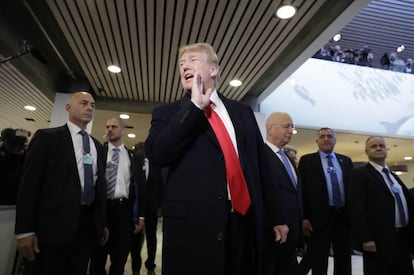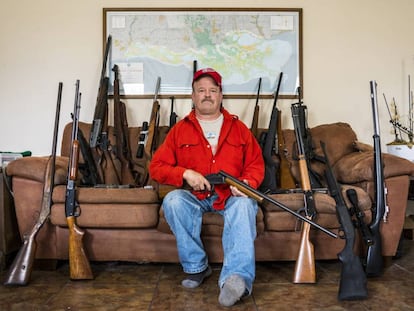Four American Tragedies
The US government is failing to protect its citizens from the predatory behavior of some corporations. Irresponsibly lax gun control, the opioid epidemic, pharmaceutical price gouging and the ravages of climate change are just four examples

The election of Donald Trump gives us just one peek into forces that keep American society divided, tense, and confused. America’s major political problems are well known: inequality, racism, terrorism, political gridlock, and declining international influence among many others.
With the exception of racism and inequality, these issues don’t touch Americans’ daily lives directly. Others do, however, in ways that are cruel, tangible and frequent.
One of these is the irresponsibly loose regulation of firearms. The figures are terrifying. The United States accounts for about 5% of the world’s population and 48% of its guns. America also has the greatest number of mass murders, especially in schools. Since 2013, there have been more than 300 school shootings in America – an average of about one a week. So far in 2018, there have already been 14 attacks. But in the US, the most dangerous place for children and young people is not school, it is the home. Many more are killed by guns in their own houses than in the classroom. The killers are usually family members or acquaintances.
Since 2013, there have been more than 300 school shootings in America – an average of about one a week
President Trump and the National Rifle Association (NRA) argue that the problem is not guns but rather mental health. But no other country faces this type of attack as regularly as the US, and, statistically, mental illness is no more frequent here than elsewhere. All independent studies conclude that the ease with which a weapon can be purchased – even what amount to machine guns – is the explanation for these massacres.
Seventy-five percent of Americans want tighter controls on the sale and possession of guns, as well as more restrictions on access to assault rifles. But the wishes of that overwhelming majority are systematically crushed by the NRA, which, though it masquerades as an NGO, in practice serves as a very effective lobby for gun-makers. It claims five million members who vote as a block against politicians who do not blindly support their extreme positions. The NRA also spends money freely to influence elections. It donated $30 million to Donald Trump’s campaign and another $3 million to Marco Rubio’s. These are minuscule amounts compared to the returns the manufacturers generate through gun sales and whose lucrative interests are well protected by the NRA. This is how a minority imposes its values on the majority.
Another toxic reality for millions of Americans centers on opioids. They can be obtained legally, by prescription, or by illegal means. Illegal consumption of heroin and synthetic opiates such as fentanyl has skyrocketed. In 2015, two million Americans suffered health problems due to abuse of these drugs. About a third of patients who start using opioids to relieve pain end up abusing them. Eighty percent of heroin addicts had previously abused prescription opiates. Every day 115 Americans die from an overdose of these drugs. Nowhere else on Earth are opiates prescribed and consumed as freely as in the United States.
Toward the end of the 1990s, pharmaceutical companies launched a vast campaign aimed at persuading doctors and hospitals that these drugs were suitable for pain relief and, above all, that they were not addictive. The result was a huge increase in prescriptions, overdoses, and cases of
addiction. It also, of course, increased the profits of these pharmaceutical companies. The government’s attempts to put limits on opioid prescriptions were shot down by the powerful pharmaceutical lobby. Again, the economic interests of a powerful and well-connected few outweighed the welfare of society as a whole.
Even as the United States is brimming with opiates that kill, it faces a serious shortage of medicines that save. This shortage is not because the drugs are not available, but because they are out of reach for millions of Americans who cannot afford them. The price of prescription drugs in the United States is the highest in the world. The average American spends $858 per year on drugs, whereas in the other 19 industrialized countries the average is $400. Twenty percent of Americans say that these high prices force them to ration the doses that doctors have prescribed or prevent them from renewing the prescription when they run out of medicine.
The behavior of some pharmaceutical companies is outrageous. In recent years, companies have increased, without explanation, the cost of insulin for diabetes patients by 325%. The price of Lomustine, a medicine for the treatment of cancer, has increased by 1,400% since 1993, even though its production costs have not increased. The price of EpiPen – an anti-allergy drug – jumped from $7 in 2007 to $500, while the price of 30 capsules of cycloserine, used to treat tuberculosis, rose from $500 to $10,800. In 2015 alone, the price of a basket of the most commonly used drugs increased 130 times faster than the rate of inflation.
The United States accounts for about 5% of the world’s population and 48% of its guns
Eighty-two percent of Americans want laws that lower drug prices. But... the lobby for the pharmaceutical companies seems to be battling it out with the NRA in the race to spend the most money blocking government initiatives that protect consumers.
Another phenomenon that is killing Americans is climate change. The year 2017 saw the most costly climate events in US history: hurricanes, forest fires, tornadoes, floods and droughts. Extreme weather events are becoming measurably more frequent. California suffered more wildfires than ever, several cities recorded their highest temperatures, and there were prolonged droughts. Hurricane Harvey broke records for rainfall and devastated Puerto Rico, where, coming on its heels, Hurricane Maria wrought even more destruction and left a thousand people dead. In February, it was warmer in the North Pole than in some parts of Europe. How do you explain the timidity with which the United States confronts this problem that, if it continues along its current path, will do enormous damage to its people, especially the poor?
Reducing the emissions that contribute to global warming can be costly for some business sectors, which, naturally, would prefer to avoid those costs or postpone them as long as possible to safeguard their profits. That is why they have contributed so effectively to fostering skepticism, which mitigates the sense of urgency and allows complicit politicians to postpone the necessary initiatives. This tactic is not new. For decades, tobacco companies funded campaigns to make the public believe that there was a “scientific debate” about whether smoking caused cancer.
This debate was fueled by “skeptical scientists” who argued that there was not enough evidence of a causal link between tobacco and cancer. Years later – and hundreds of thousands of deaths later – it was revealed that these “skeptical scientists” were sponsored by cigarette sellers, whose sole purpose was to sow confusion and prevent the government from acting to protect the public health. Something similar is happening with the “scientific debate” about climate change. Reuters has reported that 25 major US companies (Google, PepsiCo, DuPont, Verizon, etc.) fund more than 130 members of Congress, almost all from the Republican Party, who are declared skeptics of climate change and systematically block the initiatives to reduce emissions. ExxonMobil has admitted that for decades it funded organizations whose mission was to cast doubt on the scientific consensus on climate change.
The average American spends $858 per year on drugs, whereas in the other 19 industrialized countries the average is $400
What do these four tragedies have in common? Money. Or, rather, the propensity of some in business who, driven by unbridled greed, abuse their customers and society. They can do it because they have managed to capture the institutions of the State in charge of regulating them and limiting their abusive practices. And also because the government and politicians do nothing to prevent this capture. Faced with a market failure (business behaviors that harm society) they add government failure (inaction due to regulatory capture by private interests). This kind of regulatory capture is lasting only if elections fail to penalize politicians who favor special interests over the interests of voters at large. It is a symptom and a driver of democracy’s failure.
The solution is as obvious as it is difficult to achieve: to repair democracy where it is broken.
Nothing could be more urgent.
Twitter @moisesnaim
Tu suscripción se está usando en otro dispositivo
¿Quieres añadir otro usuario a tu suscripción?
Si continúas leyendo en este dispositivo, no se podrá leer en el otro.
FlechaTu suscripción se está usando en otro dispositivo y solo puedes acceder a EL PAÍS desde un dispositivo a la vez.
Si quieres compartir tu cuenta, cambia tu suscripción a la modalidad Premium, así podrás añadir otro usuario. Cada uno accederá con su propia cuenta de email, lo que os permitirá personalizar vuestra experiencia en EL PAÍS.
¿Tienes una suscripción de empresa? Accede aquí para contratar más cuentas.
En el caso de no saber quién está usando tu cuenta, te recomendamos cambiar tu contraseña aquí.
Si decides continuar compartiendo tu cuenta, este mensaje se mostrará en tu dispositivo y en el de la otra persona que está usando tu cuenta de forma indefinida, afectando a tu experiencia de lectura. Puedes consultar aquí los términos y condiciones de la suscripción digital.
More information
Archived In
Últimas noticias
The brief rise and retreat of Generation Z in Mexico
A floating school teaches children how to save Lake Atitlán
Pablo Escobar’s hippos: A serious environmental problem, 40 years on
From Andorra to Gibraltar, a black market for Ozempic exploits its success: ‘They’re the most sought-after products in the world’
Most viewed
- Why we lost the habit of sleeping in two segments and how that changed our sense of time
- Charles Dubouloz, mountaineering star, retires at 36 with a farewell tour inspired by Walter Bonatti
- Venezuela faces its most tense Christmas yet
- Trump’s obsession with putting his name on everything is unprecedented in the United States
- CBS in crisis after pulling a report on Trump’s deportations to El Salvador (which later leaked online)











































